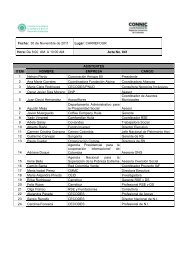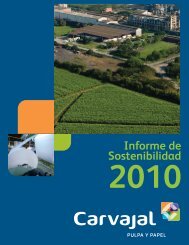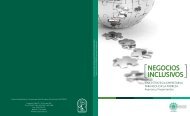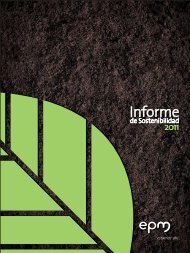Setting new standards - Friends Life
Setting new standards - Friends Life
Setting new standards - Friends Life
You also want an ePaper? Increase the reach of your titles
YUMPU automatically turns print PDFs into web optimized ePapers that Google loves.
FINANCIAL STATEMENTS<br />
IFRS FINANCIAL STATEMENTS<br />
EEV SUPPLEMENTARY INFORMATION<br />
Notes to the consolidated accounts continued<br />
1. Accounting policies continued<br />
curtailments, and the expected return on pension assets. Past<br />
service costs are recognised in the income statement on a straightline<br />
basis over the period in which the increase in benefits vest.<br />
Actuarial gains and losses are taken to the statement of recognised<br />
income and expense for the period.<br />
The actuarial gains and losses, which arise from any <strong>new</strong> valuation<br />
and from updating the latest actuarial valuation to reflect conditions<br />
at the balance sheet date, are taken to the statement of recognised<br />
income and expense for the period. The adjustment is shown net of<br />
deferred taxation.<br />
(ii) Defined contribution schemes<br />
Contributions made to these schemes are charged to the income<br />
statement as they become payable in accordance with the rules of<br />
the scheme.<br />
(iii) Multi-employer defined benefit schemes<br />
The Group participates in several multi-employer defined benefit<br />
schemes in Europe. These schemes are defined benefit schemes<br />
but the Group is unable to identify its share of the underlying assets<br />
and liabilities as they are not separately identifiable. The Group<br />
accounts for the contributions to the schemes in the same manner<br />
as defined contribution schemes.<br />
(iv) Other long-term employee benefits<br />
Other long-term employee benefits are recognised at the discounted<br />
present value of the defined benefit obligation at the balance sheet<br />
date. The obligation is calculated using the unit credit method. The<br />
discounted rate of the employees’ benefits is the yield at balance<br />
sheet date.<br />
(v) Termination benefits<br />
Termination benefits are recognised as a liability and an expense<br />
when the Group terminates the employment of an employee before<br />
the normal retirement date.<br />
(b) Share based payment schemes<br />
The Company and certain subsidiary undertakings offer share based<br />
payment schemes to employees of the Group, depending on<br />
eligibility. The fair value of equity-settled share based payments is<br />
measured at the grant date and expensed on a straight-line basis<br />
over the vesting period in the income statement. A corresponding<br />
amount is credited to equity.<br />
At each balance sheet date, the Group revises its estimate of the<br />
number of options that are expected to become exercisable. It<br />
recognises the impact of the revision of original estimates, if any, in<br />
the income statement, with a corresponding adjustment to equity<br />
over the remaining vesting period. The fair value is measured using<br />
scenario based modelling techniques that take into account the<br />
terms and conditions upon which these options were granted. The<br />
amount recognised as an expense is adjusted to reflect the actual<br />
number of share options that vest, except where forfeiture is only<br />
due to share prices not achieving the threshold for vesting.<br />
The dilutive effect of outstanding options is reflected in the<br />
computation of diluted earnings per share.<br />
For cash-settled schemes, the fair value of the share based payment<br />
is measured at the grant date and expensed over the vesting period<br />
in the income statement with a corresponding credit to liabilities.<br />
The estimated fair value of cash-settled awards is remeasured at<br />
each reporting date until the payments are ultimately settled.<br />
1.3.25 Share capital and dividends<br />
Where either the Company or F&C has a holding in its own equity which<br />
has been classified as treasury shares, the consideration paid is deducted<br />
from share capital and reserves. Where such shares are subsequently<br />
sold, reissued or otherwise disposed of, any consideration received is<br />
included in equity attributable to the Company’s equity holders, net<br />
of any directly attributable incremental transaction costs and the<br />
related tax effects.<br />
Dividends are recognised as an appropriation on the date declared by<br />
the Group’s directors or, if subject to approval, by the shareholders.<br />
2. Use of estimates, assumptions and judgements<br />
The Group makes estimates, assumptions and judgements that<br />
affect the reported amounts of assets and liabilities. Estimates,<br />
assumptions and judgements are continually evaluated and based on<br />
historical experience and other factors, including expectations of future<br />
events that are considered to be reasonable under the circumstances.<br />
(a) Liabilities arising from insurance contracts and investment<br />
contracts with DPF<br />
As stated in the accounting policies, management has determined<br />
that a contract is an insurance contract if there is a significant<br />
insurance risk. Policyholder contracts not considered insurance<br />
contracts are classified as investment contracts. Investment<br />
contracts with DPF are mainly unitised with-profit policies which are<br />
valued on the same basis as insurance contracts.<br />
The estimation of the ultimate liabilities arising is a critical accounting<br />
estimate. There are several sources of uncertainty that need to be<br />
considered in the estimation of the liabilities that the Group will<br />
ultimately pay for claims.<br />
A number of assumptions are used to determine the Group’s<br />
liabilities, which contain guarantees and options. The most<br />
significant assumptions are:<br />
• mortality, morbidity and persistency assumptions;<br />
• for with-profits policies within FPLP, the stochastic model used to<br />
value liabilities is sensitive to risk-free rates, assumed asset<br />
volatilities and the assumed correlation between asset volatilities.<br />
Risk-free rates are set in accordance with current market rates;<br />
• for other policies, the valuation interest rate is the most significant<br />
economic assumption;<br />
• for guaranteed annuity options (one of the principal guarantees<br />
written by the Group) the cost depends on assumptions such as<br />
the level of policy discontinuance and the tax-free cash take-up;<br />
82 <strong>Friends</strong> Provident Annual Report & Accounts 2006

















